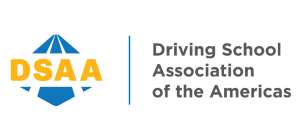To obtain a driver license you:
- Must be in the US legally
- Must provide proof of age
- Must provide proof of residence
- Must provide a social security number
- May be required to have completed a driver education and a driver-training course (if under 17.5 years of age)
- Must give a thumb print
- Must pass a vision test
- Must pass a written test showing that you understand the traffic laws of California
- Must pass behind-the-wheel test of your driving skills
 For more information about Applying for a New License in California, visit:
For more information about Applying for a New License in California, visit:
https://www.dmv.ca.gov/portal/driver-licenses-identification-cards/dl-id-online-app-edl-44/
- When you apply for an original Driver’s License or Identification card, you must present an acceptable birth date document and provide your social security number (SSN).
- If the name on your birth date document is different from the name on your DL/ ID card application, you must also bring an acceptable true full name document. This document is a certified copy of the original (the original is retained by the county or state) and contains an impressed seal or an original stamped impression. The DMV will not accept a photocopy of the certified copy for birth date/legal presence or true full name verification.
- Examples of true full name verification documents include the following:
- Adoption documents containing your legal name as a result of the adoption.
- Name change documents containing your legal name both before and after the name change.
- Marriage Certificate
- A certificate, declaration, or registration document verifying the information of a domestic partnership.
- Dissolution of marriage document containing your legal name, as a result of the court order.
- Examples of other acceptable documents:
- U.S. Birth Certificate
- Proof of Indian Blood Degree
- U.S. Passport
- U.S. Armed Forces ID Cards
- Certificate of Naturalization
- Permanent Resident Card
- Foreign passport or Mexican Border Crossing Card with a valid I-94. The I-94 expiration date must be more than 2 months from the DL/ID card application date.
 For a complete list of birth date/legal presence documents, visit:
For a complete list of birth date/legal presence documents, visit:
https://www.dmv.ca.gov/portal/news-and-media/nearly-7-6-million-californians-have-a-real-id-as-enforcement-date-approaches/
Making an Appointment
You can call to make an appointment at the DMV to apply for your license and take your tests, instead of waiting in line. Check your phone book or their website for the number of the office nearest you or for a DMV telephone service center.
 For link to make an online appointment,
For link to make an online appointment,
visit: https://www.dmv.ca.gov/portal/appointments/select-appointment-type
Vision Test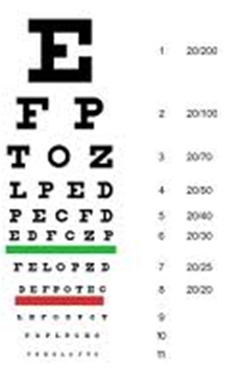
You can call to make an appointment at the DMV to apply for your license and take your tests, instead of waiting in line. Check your phone book or their website for the number of the office nearest you or for a DMV telephone service center.
Photograph Taken
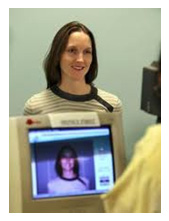 When you complete the application process and fees are paid, your photograph will be taken.
When you complete the application process and fees are paid, your photograph will be taken.
Written Test
- Your knowledge of traffic laws and safe driving practices will be assessed during the application process. Topics for the written test include:
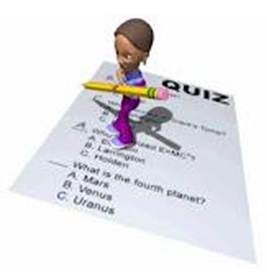
- Accident responsibility
- DUI/drugs
- Driving on freeways
- Lane markings
- Lane usage
- Parking (including on hills)
- Road hazards
- Railroad crossings
- Right-of-way
- Seat belts and child restraints
- Maintaining a space cushion
- Speed and speed limits
- Safe driving practices
- Sharing the roadway with others
- Driving with special vehicles (e.g., school buses)
- Improving traffic flow
- Traffic lights and signals
- Turns
- Traffic signs
- Visual scanning
- Driving in inclement weather
- Written Test Passing Requirements:
- The written test for provisional license applicants has 46 questions; a maximum of 7 errors is allowed.
- The written test for adult original license applicants has 36 questions; 5 errors are allowed.
- The written test for license renewal applicants has 18 questions, 3 errors are allowed.
Note:
The tests are revised a number of times each year. It is better to prepare for the test by reading the California Driver Handbook than by studying old versions of the tests.
 DMV sample video practice test
DMV sample video practice test
https://www.dmv.ca.gov/portal/driver-education-and-safety/educational-materials/sample-driver-license-dl-knowledge-tests/
 For an interactive examples of DMV exams, visit:
For an interactive examples of DMV exams, visit:https://www.dmv.ca.gov/portal/news-and-media/dmv-expands-eligibility-for-at-home-testing/
- The written knowledge test is available in more than 30 different languages and is also available on audiotape in many of these languages. However, if you take a non-English or oral test, you must also complete an additional test of your ability to recognize the meaning of common traffic signs in English.
- Provisional license applicants who fail the written test are required to wait one week before being eligible for a retest. The purpose of this waiting period is to provide sufficient time for the applicant to study The California Driver Handbook.
- If you fail the written test three times, you will have to pay a new license application fee in order to take the written knowledge test again.
Behind-the Wheel Driving Test
- During the behind-the-wheel driving test, no one except the examiner may accompany you and there may be no animals in vehicle.
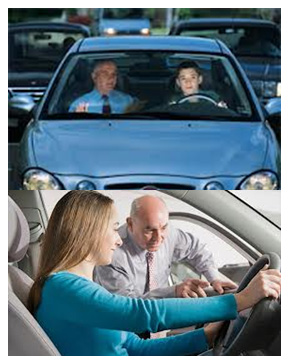
- Your vehicle must be in proper working order, which includes:
- The driver window rolling down
- The windshield being unobstructed for the driver and examiner
- Having rear-view mirrors
- The front and back turn signals working
- The brake lights working
- Tires having adequate tread
- The foot brake not touching the floorboard
- A working horn
- A working emergency/parking brake
- Locating the windshield wiper control
- Locating the defroster
- Locating the emergency flashers
- Locating the headlight switch
- The passenger door opening from inside and outside
- The glove box being closed and secure
- Seatbelts present and functional.
- Your vehicle must have a rear license plate with current year and month registration stickers
- You must show proof of financial responsibility for the vehicle (insurance)
- Show your knowledge of arm signals
- The behind-the-wheel driving test will assess your understanding of the rules of the road and your skill in handling the vehicle. The test includes:
- Dealing with through and stop intersections
- Control of the vehicle
- Parking lot driving
- Backing up
- Choosing the appropriate speed for conditions
- Judging distances
- Respecting right-of-way
- Your degree of attentiveness
- Your visual-search skills
- Business/ urban and residential/rural driving
- Lane changes
- Left and right turns.
- Under certain circumstances, you may also have to demonstrate your ability to drive on a freeway or highway.
Note:
Over 200 items are scored on the driving test. You may only make 15 or fewer errors to pass the test.
- If you make a serious driving error on the driving test, you will be automatically disqualified. These errors include:
- Performing an unsafe maneuver for which the examiner has to intervene
- Striking an object or curb with your vehicle
- Disobeying a traffic sign or signal
- Disobeying safety personnel or vehicles
- Performing a dangerous maneuver
- Driving too fast or too slow
- Improper use of auxiliary equipment
- Executing a lane violation
- If you fail the driving test three times your instruction permit will no longer be valid and you will have to pay a new license application fee in order to take the driving test again.
- The best way to prepare for the test is to take a driver training course and extensively practice the different maneuvers required on the test.
- If you are applying for a provisional license, you must wait 6 months from the date you obtain your instruction permit before you may take the driving test, unless you turn 18 before the end of this 6-month period. Provisional license applicants who fail the driving test are required to wait 2 weeks before being eligible for a retest. The purpose of this waiting period is to encourage applicants to gain additional behind-the-wheel practice.
Successful Completion of Requirements
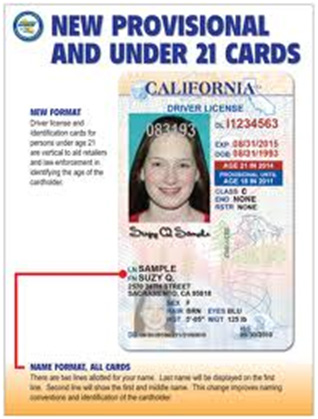
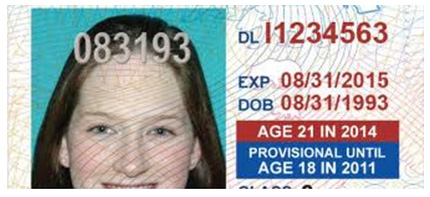
- Once you have successfully completed all the procedures, requirements and examinations for a license, you will be issued a temporary (paper) license which will permit you to operate a motor vehicle for a period of 60 days or until your actual license has been issued or refused.
- Once you have your provisional driver license, you may drive alone, as long as you do not have any collisions or traffic violations.
- When you become 18 years old, the “provisional” part of your driver license ends. You may keep your provisional photo license or pay a fee for a duplicate driver license without the word “provisional.”
- During the first 12 months after you are licensed, you cannot drive between 11 p.m. and 5 a.m. and you cannot transport passengers under 20 years of age, unless you are accompanied by a licensed parent or guardian, a licensed driver 25 years of age or older or a licensed or certified driving instructor.
- You are periodically (usually every 4 or 5 years) required to renew your driver license. You will have to pay a license renewal fee and may have to take a vision, written or driving test.
- If you fail the written test three times or are unable to pass the visual acuity test during a license renewal, you will be required to take a behind-the-wheel driving test.
- The driver must have their driver’s license in their possession whenever driving a car. The driver must show their license to law enforcement officers when requested to do so and in case of an accident, to other drivers and persons involved.
- The holder of a driver’s license shall do the following:
- If you change your address, you must notify DMV within 10 days.
- If you change your name, you must appear at a DMV office to obtain a new license.
- You must appear at a DMV office to replace a damaged or lost license. If your license is replaced and you find the old one later, you must destroy the old one.
Emergency and Donor Card
- DMV provides organ donor cards, which can be carried with your license. Organ donation has saved thousands of lives, many of which were endangered by injuries due to traffic collisions.
- The DMV provides cards which can provide emergency medical information and which can be carried with your license.
https://youtube.com/watch?v=EqXJyl0TJ3w


